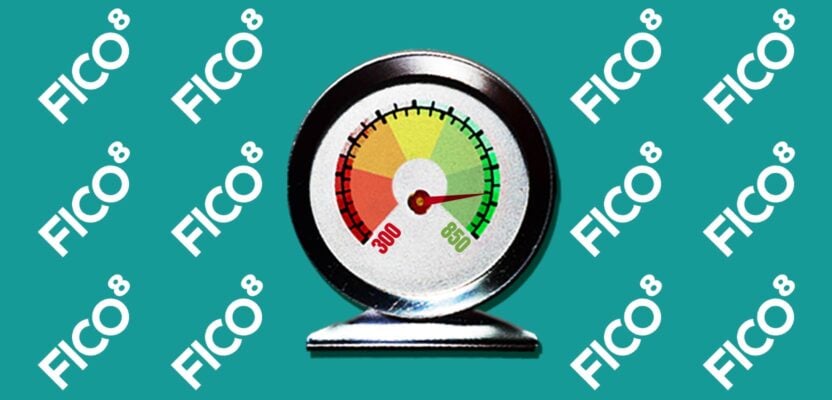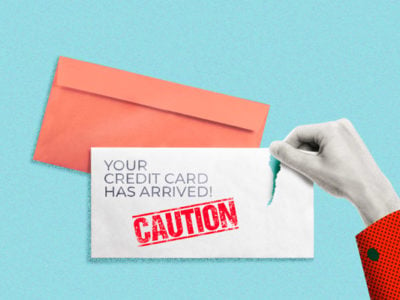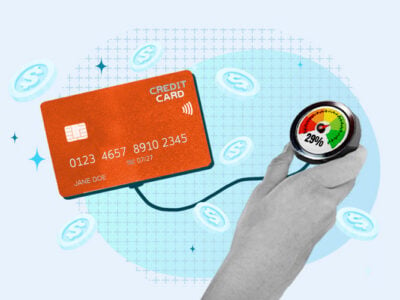In the world of credit-scoring models, FICO Score 8 remains the gold standard, used by over 90% of lenders. However, if you’ve checked your credit score recently, you may have noticed you received a score from a different FICO version, or from VantageScore (a different company). That’s because your credit score isn’t just your FICO score.
You may be wondering:
- If FICO Score 8 is the most widely used credit-scoring model, why did you receive a score from a different model or even a different company?
- Why is a credit-scoring model that’s two versions old and was released in 2009 still by far the most used?
- What’s the difference between FICO Score 8 and other credit-scoring models?
We’ll clear up those questions and more in this article.
Table of Contents
What is FICO Score 8?
FICO Score 8 is a credit-scoring model released by Fair Isaac Corporation (aka FICO). Released in 2009, it’s the 8th generation of FICO’s credit-scoring model. 1 Although FICO was founded in 1956, they released their first modern credit-scoring model in 1989.
FICO has since released two subsequent generations, FICO Score 9 and FICO Score 10. Despite claimed improvements to the model, FICO Score 8 remains the most-used credit score by lenders to determine creditworthiness.
How does FICO Score 8 compare to previous FICO models?
According to FICO, these are the major changes in FICO Score 8 compared to previous models: 2
It’s more sensitive to high credit card usage
If you frequently use a significant amount of your credit card limit, it hurts your credit score. This corresponds with FICO Score 8’s “Amounts Owed” category, which measures your credit utilization rate (aka your debt-to-credit ratio).
It’s less sensitive to isolated late payments
When you make late payments, it hurts your credit score. If you forgot to pay one time and it was an isolated incident, FICO Score 8 won’t penalize you as heavily as earlier models.
It reduces the benefits of credit card authorized user “piggybacking”:
When you become an authorized user of someone else’s credit card, that card’s balance statements also show in your credit report. This provides a benefit to your credit score (if the card is used responsibly). However, FICO Score 8 significantly reduced the benefits of becoming an authorized user.
This was done to discourage a practice known as piggybacking credit, where credit repair companies would assign strangers as authorized credit card users, essentially misrepresenting their credit risk to lenders.
It reduces impact of small-balance collections:
FICO Score 8 ignores collection accounts if the original balance was less than $100. It considers these accounts as small-dollar or “nuisance” collections.
How is a FICO Score 8 credit score calculated?
Your FICO Score 8 (and all other credit scores) are calculated by assessing the data on your credit report and breaking it down into several factors, each of which are assigned weights.
For instance, if you pay your bills late, that will be marked down on your credit report. FICO Score 8 will note how many late payments you have, how late you were on those payments (among other variables), and give you a correspondingly poor assessment, damaging your final credit score.
FICO Score 8 credit score range and ratings
FICO Score 8 credit scores range from 300 (the worst score) to 850. All previous FICO score models did as well.
| Credit Score Range | Rating |
|---|---|
| 300–579 | Poor |
| 580–669 | Fair |
| 670–739 | Good |
| 740–799 | Very Good |
| 800–850 | Exceptional |
FICO Score 8 factor weights and explanations
The following table breaks down how the FICO Score 8 credit-scoring model assesses credit reports and weights each factor.
| Factor | FICO Score 8 Factor Weights | What it assesses |
|---|---|---|
| Payment History | 35% | - Whether you pay your bills on time. Paying late hurts your credit score. |
| Amounts Owed | 30% | - Your debt-to-credit ratio. Using less of your credit limit (i.e., having a low credit utilization rate) helps your credit score. |
| Length of Credit History | 15% | - The age of your oldest account, newest account, and average age of all accounts - How long specific credit accounts have been open - How long it’s been since you’ve used them - Having a longer credit history is good for your credit score |
| Credit Mix | 10% | - Your mix of types of credit, including credit cards and installment loans - Having a mix of credit and loans shows you’re better able to manage credit. |
| New Credit | 10% | - How many credit accounts you’ve recently opened or tried to open, resulting in hard inquiries on your credit report that hurt your credit. |
Differences between FICO Score 8 and other credit-scoring models
FICO Score 8 vs. VantageScore
FICO Score 8 is a credit-scoring model released by FICO, while VantageScore is a competing company that also has several credit-scoring models. While VantageScore’s latest credit-scoring model is VantageScore 4.0, lenders and credit-checking services use VantageScore 3.0 far more frequently.
The major differences between all FICO Score and VantageScore credit-scoring models include:
- Different factors: VantageScore has six different factors, while FICO has five (as shown above). In reality, the factors are mostly measuring the same things, just with different names and groupings.
- Different factor weights: VantageScore and FICO assign different weights to their factors. For example, FICO weights Payment History at 35%; VantageScore weights it at 40%-41%
- Different credit score ratings: While both share a 300 to 850 credit score range, how those ranges are divided and rated differ slightly. For instance, FICO rates an 850 credit score as Exceptional; VantageScore rates it as Excellent.
- Different approach to modeling each bureau’s credit reports: FICO’s scoring models are all bureau-specific. VantageScore created a single tri-bureau model that can be used with a credit report from all bureaus, TransUnion, Equifax, or Experian.
Overall, FICO claims that 90% of lenders use a FICO score of some kind to make lending decisions.
For more detailed information, see how FICO Score 8 compares to:
FICO Score 8 vs. FICO Score 9
FICO Score 9 was released in 2014 (to lenders) and 2016 (to consumers). Some major changes from FICO Score 8 included: 3
- Creating credit scores using a slightly different process for consumers with a high amount of debt
- More refined treatment of consumers with “thin credit files” (meaning a limited credit history)
- Ignoring paid collections entirely, regardless of the amount
- Reducing the penalty of medical collections accounts compared to non-medical ones
- Adding rental payments as another factor for scoring a consumer’s payment history
FICO Score 8 vs. FICO 10 Suite (FICO Score 10 & 10T)
In 2020, FICO released the FICO Score 10 Suite, which consists of FICO Score 10 and FICO Score 10T.
Both FICO Score 10 and 10T use the same factors and weights that all prior models used.
The major differences include:
- Trended data: FICO Score 10T uses trended data over 24 months (rather than just recent credit history) to provide more insights into consumer behavior. (FICO Score 10 does not use trended data.) 4
- Increased predictive power: FICO claims lenders could reduce the number of defaults in their portfolios by as much as 10% among newly originated (issued) credit cards, and 9% among newly issued auto loans compared to FICO Score 9. 5
Who uses FICO Score 8?
The vast majority (90%) of financial and non-financial institutions use FICO Score 8 to make lending or other decisions. According to FICO, 10 billion FICO scores are sold each year.
FICO Score 8 credit scores are used by:
- Banks
- Credit unions
- Credit card issuers
- Mortgage, student, auto, or personal installment loan providers
- Tenant screening companies and landlords
- Consumer websites
- Government entities
Why is FICO Score 8 still so popular?
FICO Score 8 is still popular with lenders because it’s a tested model that continues to work adequately. Financial institutions are conservative and risk-averse by nature. Even though FICO claims that FICO Score 9, 10, and 10T are more predictive (and score more people) than FICO Score 8, those claims largely only exist on paper.
For many small lenders, it’s also simply practical to continue using FICO Score 8 because the biggest lenders, Fannie Mae and Freddie Mac continue to use the classic FICO Score 8. By following their lead, lenders ensure that their loans can be resold in the biggest markets. 6
Why are there so many FICO Score versions?
It’s necessary for FICO to release so many versions of its score for four main reasons
1. Consumer behavior changes over time
Consumer behavior in 1989 (when the first FICO score was released) is different from consumer behavior in 2022. Models that predict consumer financial behavior need to be updated to handle major economic events, like the great recession of 2009, among many other variables that change over time.
2. Modeling improvements
FICO’s ultimate goal is to score as many people as possible as accurately as possible. Doing so makes their score more valuable and easier to sell to lenders, because the more people that lenders can safely loan money to, the more money they’ll make.
FICO’s most recent updates to their models allow more people to be scored (despite having a limited credit history), while claiming their scores to be ever more accurate.
3. Credit report data differs between bureaus
FICO is not the same as the credit bureaus, Equifax, TransUnion, and Experian, all of which are also separate companies. Lenders don’t necessarily report to each bureau, and each bureau structures their data differently.
For you, this means you have three different credit reports, each of which will provide a different credit score (even if you use the same credit-scoring model).
For FICO, this means their credit-scoring models need to work with different data and with different data structures, because the way in which each bureau stores and reports information is different.
For instance, for mortgage lending, FICO had to develop:
- For Experian: FICO Score 2
- For Equifax: FICO Score 5
- For TransUnion: FICO Score 4
If you were denied a mortgage by a lender who checked your TransUnion credit report, you’d want to find out what your FICO Score 4 credit score is, and why it’s low.
4. Specific industries (auto, mortgage, or bank cards) require specific credit-scoring models
While a FICO Score 8 may be generally predictive of consumer financial behavior, it may not be as good as industry-specific credit-scoring models. For instance, auto lenders may see red flags in a consumer’s credit report that a bank card issuer would not.
Full list of FICO Score versions
| Score | Equifax | Experian | TransUnion |
|---|---|---|---|
| Most widely used | FICO® Score 9 FICO® Score 8 | FICO® Score 9 FICO® Score 8 | FICO® Score 9 FICO® Score 8 |
| Used in auto lending | FICO® Auto Score 9 FICO® Auto Score 8 FICO® Auto Score 5 | FICO® Auto Score 9 FICO® Auto Score 8 FICO® Auto Score 2 | FICO® Auto Score 9 FICO® Auto Score 8 FICO® Auto Score 4 |
| Used in credit card decisioning | FICO® Bankcard Score 9 FICO® Bankcard Score 8 FICO® Bankcard Score 5 | FICO® Bankcard Score 9 FICO® Bankcard Score 8 FICO® Score 3 FICO® Bankcard Score 2 | FICO® Bankcard Score 9 FICO® Bankcard Score 8 FICO® Bankcard Score 4 |
| Used in mortgage lending | FICO® Score 5 | FICO® Score 2 | FICO® Score 4 |
| Newly released | FICO® Score 10 FICO® Auto Score 10 FICO® Bankcard Score 10 FICO® Score 10T | FICO® Score 10 FICO® Auto Score 10 FICO® Bankcard Score 10 FICO® Score 10T | FICO® Score 10 FICO® Auto Score 10 FICO® Bankcard Score 10 FICO® Score 10T |
Data taken from FICO. 7
How can I check my FICO Score 8?
There are many ways to check your FICO Score 8, or any other FICO score. Note that it doesn’t hurt your credit when you check your own score.
1. Go to myfico.com (owned by FICO)
Choose either a monthly subscription plan to keep closer track of your credit score, or a one-time report to see a snapshot of how you’re doing. FICO’s cheapest plans only cover one bureau, and the most expensive ones cover all three.
Pros:
- Visibility into all 28 versions of your FICO Score credit scores
- Access to all scores at all three credit bureaus
Cons:
- Premium plan is expensive at 39.95/mo
2. Go to Experian.com, an authorized FICO score retailer
Simply register an account at experian.com to get access to your FICO Score 8 credit score (based on your Experian credit report)
Pros:
- Completely free, no credit card needed
- Updates every 30 days on sign in
- Provides access to Experian Boost
- Provides credit monitoring
Cons:
- Only provides FICO Score 8 credit score
- Only provides a score based on your Experian credit report
3. Check if your bank, credit card issuer, auto lender, mortgage servicer, or credit and financial counselor participates in FICO Score Open Access
FICO Score Open Access is a program run by FICO that aims to help educate consumers about FICO scores.
You can view a list of all FICO Score Open Access partners here. If you have a relationship with one of the partners, you’ll get free access to the FICO score they use to manage your credit account, as well as the top factors affecting your scores.
Pros:
- Completely free, no credit card needed
Cons:
- Partner’s FICO Score may be limited to a specific model or credit bureau
- Requires a relationship with one of the partners
How can I improve my FICO Score 8?
If you noticed you have a low FICO Score 8 credit score, you’ll need to do the following:
- Pay your bills on time and in full each month
- Pay off any bills you’re late on currently
- Try not to use your credit cards extensively, and keep a low debt-to-credit ratio
- Manage your credit responsibly and try to get a mix of loans and credit card accounts
Takeaway: FICO Score 8 is currently the most popular credit-scoring model in the world
- Although it’s not as current as FICO’s updated models, such as FICO 9 and 10, FICO 8 is still the model most commonly used by lenders.
- FICO claims that FICO Score 8 is used in 90% of all lending decisions.
- It’s possible to check your FICO 8 score in many different places, including on FICO’s own website.
- Competing credit-scoring models include VantageScore 3.0 and 4.0. Your score will be different in each model, although in practice, all of your credit scores are strongly correlated with each other.







